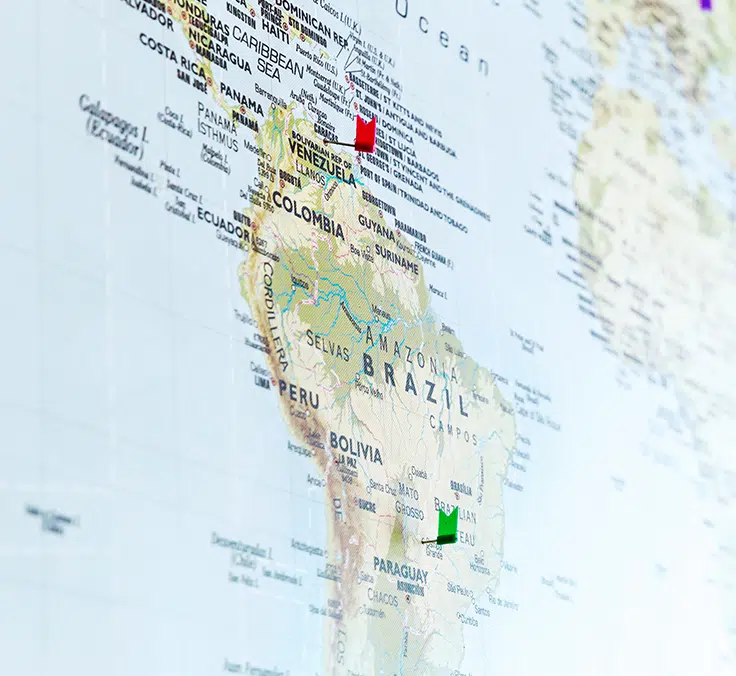INNOVATION| 03.04.2025
Overview of the Insurtech Ecosystem in Latin America in 2024
The insurtech ecosystem in Latin America is experiencing a paradox: funding is low, yet more and more players are trying to drive the market forward. After a challenging 2024, 2025 began with a more positive outlook thanks to new announcements of funding rounds.
The year 2024 was characterized by a balance in which economic activity remained close to its potential, showing resilience against global uncertainties, and where the control of the inflationary process was a constant. For 2025, sustained global economic growth is expected and a slowdown in average inflation, which will allow central banks to better manage their environment, increasing the likelihood of adopting a neutral stance.
In this context, MAPFRE Economics, MAPFRE’s research arm, once again improved the growth forecast for the world economy to 3.1% this year, one tenth higher, and 3% next year, according to the report “Economic and industry outlook 2025,” published by Fundación MAPFRE.
In the specific case of Latin America, the same report states that the region will increase its GDP by 1.6% this year and by 1.7% next year. However, its strong economic ties with the United States could heighten its overall vulnerability. MAPFRE Economics projects a mixed but positive economic performance, with average inflation across Latin American countries reaching 8.6% in 2025 and 8% in 2026.
“The economic situation in Latin America is complex, and that is also being reflected in venture capital,” stated Carlos Cendra, Scouting & Investment Lead in Corporate Innovation at MAPFRE. “If we focus on the insurtech ecosystem, we see clear similarities with the macroeconomic context, with declines in funding. Nevertheless, markets that are making great efforts to continue pushing towards a 2025 with better results,” he adds.
The adverse context does not stop entrepreneurs
Although the first half of 2024 closed with the lowest funding in history—26 million dollars—the second half of the year concluded with more positive, albeit low, figures: investment reached 92 million dollars, 38% less compared to 2023. This is according to the Latam Insurtech Journey report prepared by Digital Insurance LatAm with the sponsorship of MAPFRE.
“This decline was driven by investors’ caution in the uncertain economic environment and the difficulties many insurtech startups had in generating long-term profitability. However, the second half of the year showed positive signs with a rebound of 156%, suggesting that investors still see opportunities in the sector. We are optimistic that they will point to a higher investment volume in 2025,” says Carlos Cendra.
Despite the reduction in total available capital, Brazil and Mexico continue to be the main recipients of investment, concentrating 33% and 32% of the total, respectively. This is largely due to the maturity of their markets and policies to support innovation that have encouraged the growth of startups.
Brazil has positioned itself as a leader in regulatory innovation thanks to its sandbox in the insurance sector, a controlled environment where companies can test new business models without being subject to the regulations of a traditional insurer. Today, 17 insurtechs are operating within this program, with 92% growth in premiums issued. Its success has been key to attracting investment and promoting innovation in Brazil, and other countries in the region are expected to adopt similar regulatory frameworks in the coming years.
Analyzing the total number of agents, the Latam Insurtech Journey report indicates that there are currently over 500 insurtechs in the region, which represents a 5% growth compared to the previous year. Brazil (206), Mexico (120), and Argentina (88) are the countries with the highest number of startups, and the Pacific region has the highest percentage growth, with Peru (+26%), Chile and Ecuador (+21% each) and Colombia (+18%) standing out.
A key factor for this development is internationalization: during the past year, there has been a 16% increase in the expansion of Latin American insurtechs to other markets, while the region has attracted 29% more foreign startups. Mexico and Colombia were the main destinations for these companies due to regulatory stability and the growth of the insurance industry in both countries.
“The rebound in funding in the second half of 2024, coupled with the continued growth in the number of startups, highlights the strength of the ecosystem and the region, which remains firmly convinced of the potential of the insurance industry.” We have started 2025 with new announcements of funding rounds, such as those of Sami and Olé Life, so everything seems to indicate that in 2025 we will see a positive trend in the figures. However, we have to be aware of the global situation of venture capital and how possible fluctuations can affect Latin America,” says Carlos Cendra.
Largest investments in 2024
Not all funding rounds are public, but considering those that are, these have been the largest investments in 2024:

Chart 1: insurtech startups with the most funding in 2024. Source: Latam Insurtech Journey
Outlook for 2025
What will this year be like for the insurance sector in the region? The expected economic recovery—with an estimated growth of 2.1% according to the aforementioned report from MAPFRE Economics—is anticipated to drive the demand for insurance products and foster a more favorable environment for investment in sector startups.
If the financing trend observed in the second half of 2024 continues, next year it could be key to consolidating insurtech with solid business models. The collaboration between startups and traditional insurers will continue to grow, while innovations such as artificial intelligence and big data will play a crucial role in optimizing processes and personalizing offerings.
Transformation remains a priority for the sector, and new insurance and business models, such as embedded insurance and bancassurance 4.0, are redefining how insurance reaches consumers.
For Carlos Cendra, “the Brazilian sandbox has proven to be a success story in flexible regulation, and other countries in the region could follow this path to encourage innovation.” With a moderate economic recovery and the drive of new technologies, the region’s insurtech ecosystem faces 2025 with measured and justified optimism.”
RELATED ARTICLES:




